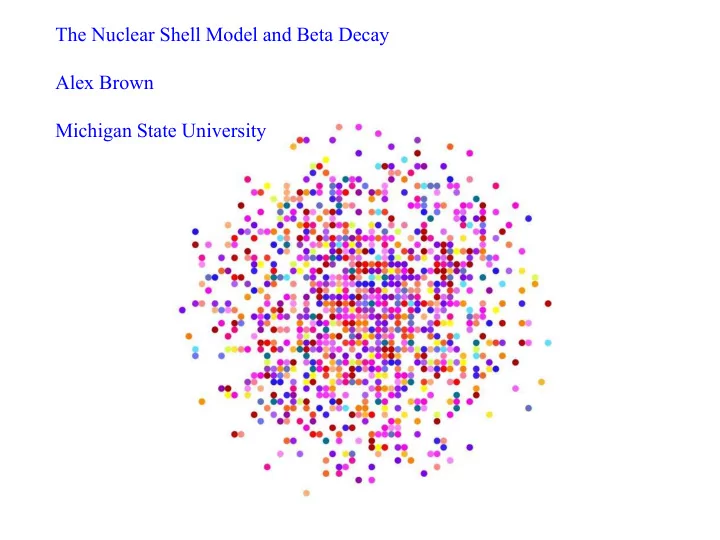

The Nuclear Shell Model and Beta Decay Alex Brown Michigan State University
Alex Brown, ND2013, NYC, March 4, 2013
Alex Brown, ND2013, NYC, March 4, 2013
Alex Brown, ND2013, NYC, March 4, 2013 Alex Brown, Krakow, June 26, 2012
f 7/2 model space Alex Brown, ND2013, NYC, March 4, 2013
pf model space both spin-orbit partners are included Gamow-Teller Sum rule is full filled in the model space
j4 model space Some spin-orbit partners are missing
1950s, 1960s Cohen, Kurath, Talmi, Lawson…. f 7/2 p One could understand all details in terms of specific shell-model configurations Alex Brown, ND2013, NYC, March 4, 2013 Alex Brown, Krakow, June 26, 2012
sd p Alex Brown, ND2013, NYC, March 4, 2013 Alex Brown, Krakow, June 26, 2012
pf sd p
jj44 pf sd p Alex Brown, ND2013, NYC, March 4, 2013 Alex Brown, Krakow, June 26, 2012
The computational challenge 10 11 matrix dimension 10 9 matrix dimension 10 5 matrix dimension jj44 means f 5/2 , p 3/2 , p 1/2 , g 9/2 orbits for protons and neutrons
jj44 means f 5/2 , p 3/2 , p 1/2 , g 9/2 orbits for protons and neutrons
Toi (Table of Ham Isotopes) Hamiltonian Input programs NuShellX@MSU wrapper Observables and Graphics NuShellX Outputs for energies *.lpt library of published <|a+|> *.lsf Hamiltonians <|a+ a|> *.obd (sps folder) <|a+ a+|> *.tna postscript (*.eps) (*.pdf) *.sp model space files figures *.int Hamiltonian files Alex Brown, ND2013, NYC, March 4, 2013
NuShellX (Bill Rae) starts with good-J proton and neutron basis states. Then a good-J pn basis is generated from vector coupling: Fortran95 OpenMP (uses up to about 32 cores) The Hamiltonian matrix is obtained “on the fly” Alex Brown, ND2013, NYC, March 4, 2013
pf Alex Brown, ND2013, NYC, March 4, 2013 Alex Brown, Krakow, June 26, 2012
Example for 56 Ni in the pf shell Alex Brown, ND2013, NYC, March 4, 2013
Example for 56 Ni in the pf shell Alex Brown, ND2013, NYC, March 4, 2013
Example for 56 Ni in the pf shell Alex Brown, ND2013, NYC, March 4, 2013
The key is to optimize the sums in this equation for OpenMP and/or MPI Alex Brown, ND2013, NYC, March 4, 2013
Hamiltonian
Wick’s theorem for a Closed-shell vacuum filled orbitals
Closed-shell vacuum filled orbitals Closed shell “core” energy
Closed-shell vacuum filled orbitals Closed shell Single particle “core” energy energy From experiment or EDF models
Closed-shell vacuum filled orbitals Renormalized nucleon-nucleon interaction Closed shell Single particle “core” energy energy From experiment or EDF models
Closed-shell vacuum filled orbitals “tuned” (adjusted) valence two-body matrix elements Closed shell Single particle “core” energy energy From experiment or EDF models
Shell Model Hamiltonians • Core energy and single-particle energies are taken from experiment (or in their absence some HF-EDF predictions) • For the two-body part - start with an ab-initio Hamiltonian based on measured NN and then renormalized into the model space. • Some combinations of two-body matrix elements (10-30) are adjusted to fit energy data – single-valued decomposition • Hamiltonian is model-space dependent • Result is that all BE and levels up to about 5 MeV can be reproduced or predicted with an rms deviation of 100-200 keV • Examples – p-shell - Cohen-Kurath, CKI, CKII, CKPOT – sd-shell - USD, USDA, USDB – pf-shell - FPD6, KB3, KB3G, GPFX1, GPFX1A – p-sd-shell (Nhw) - WBP, WBT – sd-pf-shell - SDPF-M
model space vertical expansion particle-hole configurations for all orbitals 1) QRPA in a) jj44 = (0f 5/2 , 1p 3/2 , 1p 1/2 , 0g 9/2 ) b) fpg = 0f 7/2 , (0f 5/2 , 1p 3/2 , 1p 1/2 , 0g 9/2 ) 0g 7/2 c) 21 orbits (as on the left) 2) Many-body perturbation theory (MBPT) to include 2 particle-2 hole (2p-2h) excitations to high excitation. 3) ∆ particle admixtures and mesonic exchange currents (MEC) Alex Brown, ND2013, NYC, March 4, 2013 Alex Brown, Krakow, June 26, 2012
Alex Brown, ND2013, NYC, March 4, 2013
Alex Brown, ND2013, NYC, March 4, 2013
Alex Brown, ND2013, NYC, March 4, 2013
USDB x 0.14 0.14 99.3 99.9 0.56 0.0005 Alex Brown, ND2013, NYC, March 4, 2013
Alex Brown, ND2013, NYC, March 4, 2013
Alex Brown, ND2013, NYC, March 4, 2013
Alex Brown, ND2013, NYC, March 4, 2013
Alex Brown, ND2013, NYC, March 4, 2013
Alex Brown, ND2013, NYC, March 4, 2013
Alex Brown, ND2013, NYC, March 4, 2013
exp USDB USDA USD B(M1) 2+ to 1+ 1.95 1.92 1.96 1.80 B(M1) 2+ to 3+ 3.0 6.7 13.0 6.7 x 10 -3 B(GT) 3+ to 2+ 2.7 1.6 0.13 0.8 x 10 -4 USDB M1(b) GT(c) + + for the matrix elements ????? But < na22 2+ ||F+|| ne22 2+ > = -3.16 This means the b and c matrix elements have the opposite sign Alex Brown, ND2013, NYC, March 4, 2013
3+ to 2+ USDB USDA USD M(s-tau) (c 1 ) 0.042 0.012 0.027 M(l-tau) (part of b) -1.07 -1.00 -1.00 M(d-tau) 0.062 0.081 0.066 Relative phases look robust but s-tau is not very uncertain so we should look at b/d (not b/c and d/c) Alex Brown, ND2013, NYC, March 4, 2013
Alex Brown, ND2013, NYC, March 4, 2013
Recommend
More recommend